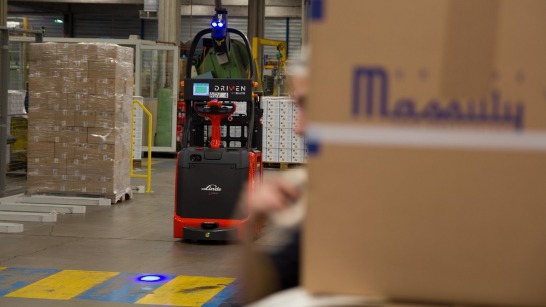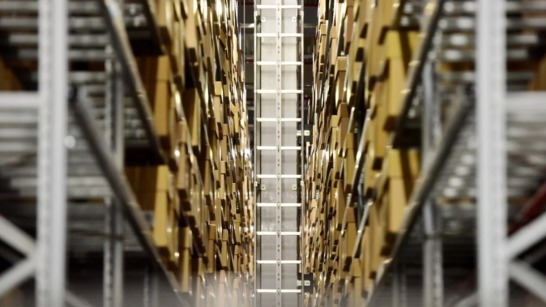It's like a roller coaster ride for metal packaging. Sparkling silver sheet metal parts move through Massilly's spacious factory hall in Cluny, France, on conveyor belts that seem to go on forever. In the middle of all of these belts, fully automated machines work on the details: cutting to size, punching lids, welding, printing and finishing. There's a constant hum of knocking, hissing and stamping going on. “A tin can looks so simple, but it's an extremely intricate object, from a technical perspective,” notes Christophe Marteau, the chief technology officer (CTO) at the family-owned company. It needs precise dimensions, heat resistance and elasticity.
The company has made a conscious decision to invest in automation. “If we want to set ourselves apart from our competitors in the emerging markets, we don't have many levers,” Marteau admits. Quality is one, and a super lean production process is another. “Automation may not create any new jobs,” he says, adding, “but it protects the ones already there.” He remains standing a few steps away from a packing station where a large, robotic arm is picking up newly filled boxes of lids and loading them onto pallets. A red pallet stacker with a huge frame, broad fork and a body with lights and electronics is parked motionless beside it. As soon as a pallet is full, the Linde L-MATIC starts moving, completes a half-turn, loads up the pallet and drives it to another station a few meters away, where it is wrapped in plastic film, and finally on to the ramp, which marks the transition from the factory to the high-bay storage facility. The entire process is automatic; controlled by robotics.
Automation is continually advancing in production lines: robots no longer work only in cages on assembly lines, machines communicate with each other and a typical car production facility now has more robots than people. 'Industry 4.0' is a buzzword that represents a tidal change and routine jobs are ideally suited for automation. Indeed, there are quite a few production employees moving between the conveyor belts, but hardly anyone is sorting parts or lifting loads; these tasks are done by machines. A factory employee's main tasks involve monitoring, checking and making swift corrections. Founded in Burgundy in 1911, Massilly is a French metal packager with 20 production sites in 15 countries and with a global workforce of nearly 1,300. In France, it is the market leader in lid production, or 'twist-off' caps and it is the third-largest producer worldwide.
The company's main production site began testing robot-controlled vehicles back in 2012. From the beginning, it was all about dealing with increasing orders: Massilly produced 1.5 billion lids in 2011. Three years later, the number had jumped to two billion. Marteau saw great potential in the emerging technology. In early 2016, Massilly increased its fleet of Linde robotic vehicles to four. “Our products are constantly changing,” says Marteau. It also includes changes to the material flow and factory layout. Couldn't they have bridged the path between the packing station and warehouse with a conveyor belt? Marteau shakes his head. “It would have blocked important routes. The vehicles provide us with flexibility and they can also take a totally different route at any time.”
To do so, the vehicles depend on natural target navigation provided by French robotics specialist Balyo, which entered a partnership with Linde in 2015. Using the technology, the automated trucks can find their way around the factory floor on their own. They don't need laser reflectors or rails, but instead use structural elements, such as walls and shelving. Thus, they can also handle significant distances with little problem. The two newest pallet stackers take their pallets from the other end of the factory to the warehouse and at a pretty impressive speed. Barely raising her eyes, a factory employee sidesteps one of the vehicles as if self-driving industrial trucks were the most natural thing in the world. Which is precisely what they are here in the factory. According to Marteau, transport is is running more smoothly under the new system and the number of incidents has significantly dropped. “A Linde robotic truck always operates in the same reliable way,” he explains. Vehicles driven by humans require the operator's full concentration when setting off or estimating speed, while automated trucks never make a misjudgment.
Meanwhile, executives from a range of well-known companies are coming from all over the world to see the trucks in action and to quiz Marteau on his experience. Because the four industrial trucks here in Cluny are performing standard tasks, it means they could be doing these same tasks at any production plant in the world, which is precisely why they attract visitors. Meanwhile, Marteau is already setting his sights on the future. He notes that the warehouse would also be suitable for automated vehicles. On the way back to his office, Marteau passes two industrial trucks that are being operated by employees. Is there a particular difficulty here that can't be solved by automation? “These are being manually driven because we can't automate everything at once,” Marteau responds. “But this will be our next step; We believe in the power of innovation.”

_image_546x307.jpg)
